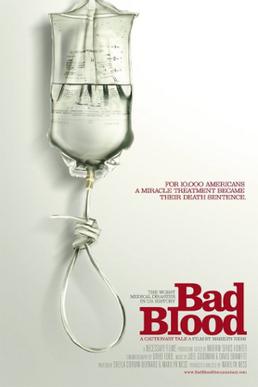Bad Blood: A Cautionary Tale
Bad Blood: A Cautionary Tale is a documentary film that explores the complex history and significant impact of the contaminated blood scandal that affected the hemophilia community in the United States during the 1970s and 1980s. Directed by Marilyn Ness, the film delves into the devastating consequences of the introduction of blood-borne pathogens, such as HIV and hepatitis C, into the blood supply, and the subsequent infection of thousands of people with hemophilia who relied on blood products for treatment.
Synopsis[edit | edit source]
Bad Blood: A Cautionary Tale presents a comprehensive overview of the events leading up to the contaminated blood scandal. It highlights the initial excitement within the hemophilia community over the development of Factor VIII concentrate, a blood product that promised to significantly improve the quality of life for those living with the condition. However, the documentary reveals how the lack of proper screening and regulatory oversight allowed HIV and hepatitis C to contaminate the blood supply.
Through interviews with survivors, family members of those who were affected, doctors, and researchers, the film paints a harrowing picture of the tragedy that unfolded. It also examines the role of pharmaceutical companies, the government, and healthcare providers in the scandal, raising questions about responsibility, ethics, and the need for systemic change to prevent similar disasters in the future.
Impact[edit | edit source]
The release of Bad Blood: A Cautionary Tale brought renewed attention to the contaminated blood scandal, sparking discussions about patient safety, the importance of rigorous testing and regulation of medical products, and the rights of patients to be informed about the treatments they receive. The documentary has been used as an educational tool to advocate for better practices in the collection, testing, and distribution of blood products.
Reception[edit | edit source]
Critics and viewers alike have praised Bad Blood: A Cautionary Tale for its thorough investigation and sensitive portrayal of a difficult subject. The film has been recognized for its ability to humanize the statistics associated with the contaminated blood scandal, providing a voice to those who suffered as a result of systemic failures.
Legacy[edit | edit source]
The legacy of the contaminated blood scandal, as depicted in Bad Blood: A Cautionary Tale, continues to influence public health policy, medical ethics, and the practices of the pharmaceutical industry. The documentary serves as a powerful reminder of the consequences of negligence and the importance of vigilance in protecting public health.
Navigation: Wellness - Encyclopedia - Health topics - Disease Index - Drugs - World Directory - Gray's Anatomy - Keto diet - Recipes
Search WikiMD
Ad.Tired of being Overweight? Try W8MD's physician weight loss program.
Semaglutide (Ozempic / Wegovy and Tirzepatide (Mounjaro / Zepbound) available.
Advertise on WikiMD
WikiMD is not a substitute for professional medical advice. See full disclaimer.
Credits:Most images are courtesy of Wikimedia commons, and templates Wikipedia, licensed under CC BY SA or similar.Contributors: Prab R. Tumpati, MD

